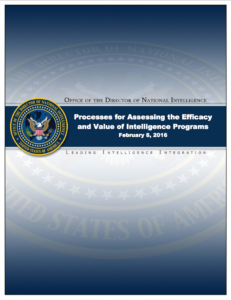I Con the Record Rolls Out Its 3-Page Intel Collection Efficacy Process
 Last year, PCLOB suggested that the intelligence community formalize its process to assess the efficacy of intelligence collection. While it made the recommendation as part of its 702 report, the recommendation itself came against the background of Congress and the IC having decided that the phone dragnet wasn’t really worth the cost and privacy exposure.
Last year, PCLOB suggested that the intelligence community formalize its process to assess the efficacy of intelligence collection. While it made the recommendation as part of its 702 report, the recommendation itself came against the background of Congress and the IC having decided that the phone dragnet wasn’t really worth the cost and privacy exposure.
I Con the Record just released a report on the processes the IC now uses to conduct such efficacy assessments; the report itself is actually dated February 8. Here’s what the report addressing this complex subject includes:
Page 1: Formal cover
Page 2: [PAGE INTENTIONALLY LEFT BLANK]
Page 3:
- Introductory paragraph
- Two paragraphs laying out PCLOB recommendation
- Two paragraphs discussing “Assessing Efficacy and Value”
- One paragraph describing that one must make both quantitative and qualitative judgements
- One paragraph introducing the “comprehensive processes”
Page 4:
- Four paragraphs on the National Intelligence Priorities Framework (see this document for a summary of what the NIPF looked like in 2013), citing both PPD-28’s mandate to consider privacy implications and ODNI’s updated ICD 204 which includes this paragraph (but no mention of the FBI and military/covert operations exceptions to this mandate):
PPD-28 specifically requires consideration of the value of Signals Intelligence activities and the risks of potential exposure of those activities to U.S. foreign policy, defense, commercial, economic, and financial interests, international agreements, privacy concerns, and the protection of intelligence sources and methods.
- The first of two paragraphs on the IC’s “Refined Process on SIGINT Targeting” describing how requiring heads of policy departments to sign off on priorities ensures that senior policymakers provide “comprehensive” oversight of “potentially sensitive” SIGINT collection
Page 5:
- The second paragraph on the IC’s “Refined Process on SIGINT Targeting” describing how, if the senior policymakers decide the risks of collection on a target outweighs its value, they will terminate the collection
- Four paragraphs on “Assessing IC Reporting,” describing how ODNI performs a quantitative (counting reports, including those that get into important reports like the President’s Daily Briefing) and qualitative review of resources dedicated to priorities and production from those units
Page 6 (a half page):
- Two paragraphs on other processes
- One paragraph noting that individual elements conduct their own assessment
- One paragraph describing the Intelligence Community Inspector General’s own assessments, noting especially that USA Freedom Act required he complete an assessment of the information acquired under FISA’s Business Records provision
- One paragraph describing a “Path Forward” that might include using prediction markets to identify the most valuable intelligence, but noting such an approach is in a “nascent stage”
Overall, there are just three pages of meat, none of which is terrifically impressive.The reference to the USAF report on assessing the value of intelligence coming from a program underscores that such reporting requirements don’t exist for all other programs. And nowhere in the discussion is any consideration whether the same information might be acquired via less intrusive means (as has happened with the phone dragnet), something that would seem central to balancing trade-offs.
In short, it’s not so much a real process for assessing the value of intelligence against the risks of it, rather than a declaration that policymakers (you know? The people who want to expand their budgets?) will decide.
